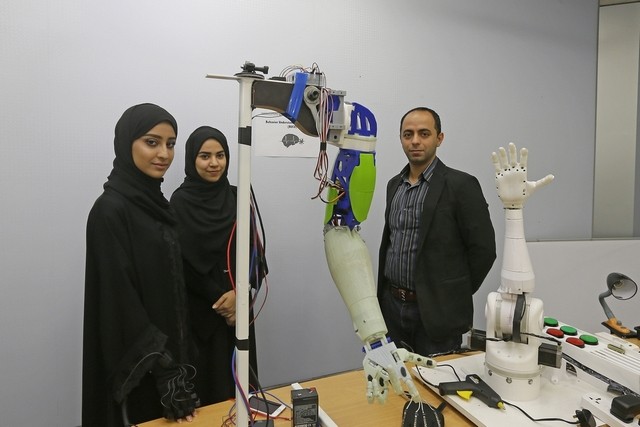![]() There’s hardly a day goes by that we don’t hear a story of the advances that are being made in 3D printed prosthetic limbs. Organizations such as e-NABLE and others are continually pushing the boundaries in efforts to help people, most especially children, to get the best prosthetic possible. This latest bit of news from the world of 3D printed limb replacements is a bit different. This particular project is a 3D printed robotic arm developed by students at the United Arab Emirates Univeresity College of Information Technology and was designed to help patients as they undergo therapy to help them regain functionality after a stroke. As Assistant Professor Dr. Fady al Najjar, who acted as project supervisor, explained:
There’s hardly a day goes by that we don’t hear a story of the advances that are being made in 3D printed prosthetic limbs. Organizations such as e-NABLE and others are continually pushing the boundaries in efforts to help people, most especially children, to get the best prosthetic possible. This latest bit of news from the world of 3D printed limb replacements is a bit different. This particular project is a 3D printed robotic arm developed by students at the United Arab Emirates Univeresity College of Information Technology and was designed to help patients as they undergo therapy to help them regain functionality after a stroke. As Assistant Professor Dr. Fady al Najjar, who acted as project supervisor, explained:
“The idea started with a rehabilitation robot for people who had a stroke and lost their motion. You really need time to completely recover and going to hospital and finding an appointment will give you rehabilitation twice a week at most, which isn’t enough. So you have to rehabilitate yourself at home.”

From left: Mouza Alahbabi, Nouf Alsaedi, and Fady Al Najjar [Image: Jeffrey E Biteng / The National]
In addition to targeting a less obvious market, the arm also got funding from a surprising source: the UAE Armed Forces. This funding was given so that the prosthetic could not only address its medical therapy needs but also so that its possibilities as an aid in the removal of explosives could be fully explored. As such, the arm itself has a camera and works by being attached to a robotic upper body that is mounted on a track. This arm could then be used to examine suspicious bags and packages while greatly reducing the risk to living bomb disposal experts.
The students who created the robotic arm found themselves energized by both the medical and military goals of their project. And it has whetted their appetites to continue to create. One member of the two-woman team, 21-year-old computer science major Hajar Alshehhi, described the excitement of being involved in this kind of project:“We also think about it as dealing with bombs. So, instead of sending a man into the field, we could just send this robot so injury to humans will be minimized. It’s something that’s needed and it made me want to build more in the future. I just love it and I want to do anything in this field because it can really improve people’s lives, from medical and educational to police.”
While the arm does cost approximately $2,700 (Dh10,000), that cost is insignificant when compared with the loss of life or limb by police and explosive ordinance professionals in the execution of their duties. The United Arab Emirates has made quite a solid commitment to the development of 3D printing in all areas of life, and in these two students, the payoff is already extremely clear. Discuss in the 3D Printed Robotic Arm forum at 3DPB.com.
[Source: The National]
Subscribe to Our Email Newsletter
Stay up-to-date on all the latest news from the 3D printing industry and receive information and offers from third party vendors.
Print Services
Upload your 3D Models and get them printed quickly and efficiently.
You May Also Like
Reinventing Reindustrialization: Why NAVWAR Project Manager Spencer Koroly Invented a Made-in-America 3D Printer
It has become virtually impossible to regularly follow additive manufacturing (AM) industry news and not stumble across the term “defense industrial base” (DIB), a concept encompassing all the many diverse...
Inside The Barnes Global Advisors’ Vision for a Stronger AM Ecosystem
As additive manufacturing (AM) continues to revolutionize the industrial landscape, Pittsburgh-based consultancy The Barnes Global Advisors (TBGA) is helping shape what that future looks like. As the largest independent AM...
Ruggedized: How USMC Innovation Officer Matt Pine Navigates 3D Printing in the Military
Disclaimer: Matt Pine’s views are not the views of the Department of Defense nor the U.S. Marine Corps Throughout this decade thus far, the military’s adoption of additive manufacturing (AM)...
U.S. Congress Calls Out 3D Printing in Proposal for Commercial Reserve Manufacturing Network
Last week, the U.S. House of Representatives’ Appropriations Committee moved the FY 2026 defense bill forward to the House floor. Included in the legislation is a $131 million proposal for...


































